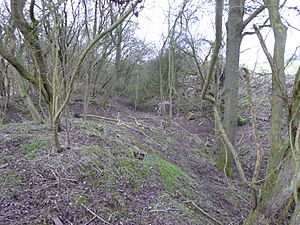Thrapston Station Quarry facts for kids
| Site of Special Scientific Interest | |
 |
|
| Area of Search | Northamptonshire |
|---|---|
| Interest | Geological |
| Area | 4.5 hectares |
| Notification | 1986 |
| Location map | Magic Map |
Thrapston Station Quarry is a special place in Northamptonshire, England. It's known as a Site of Special Scientific Interest (SSSI) because of its amazing geology. This means it's protected for its important rocks and fossils.
Contents
Discovering Thrapston Station Quarry
This quarry covers about 4.5 hectares, which is like 11 football fields! It's located south of the town of Thrapston. The site is very important for understanding Earth's history. It's also a Geological Conservation Review site, meaning it's one of the best places in Britain to study geology.
What Makes This Quarry Special?
Thrapston Station Quarry holds the most important rock layers from the Middle Jurassic period in the Midlands. These layers are part of something called the Cornbrash Formation. The Middle Jurassic period was a very long time ago, about 168 to 166 million years ago!
This quarry is also the "type site" for a specific rock layer called the Blisworth Clay section. A "type site" is like the main example or original place where a certain rock layer was first studied and named. This quarry is the only place where you can see this entire rock section clearly.
Ancient Life Found Here
Scientists have found special ammonite fossils here. Ammonites were ancient sea creatures with spiral shells, a bit like snails, but they lived in the ocean. These fossils help scientists figure out the exact age of the rocks.
The quarry has also given us important Bryozoan fossils. Bryozoans are tiny, colonial animals that live in water. They often look like moss or small plants, but they are actually animals. Finding these fossils helps us learn about the ancient environments of the Earth.
Visiting the Quarry
It's important to know that Thrapston Station Quarry is on private land. This means there is no public access to the site. It's protected so that its unique geological features and fossils can be preserved for future study.

